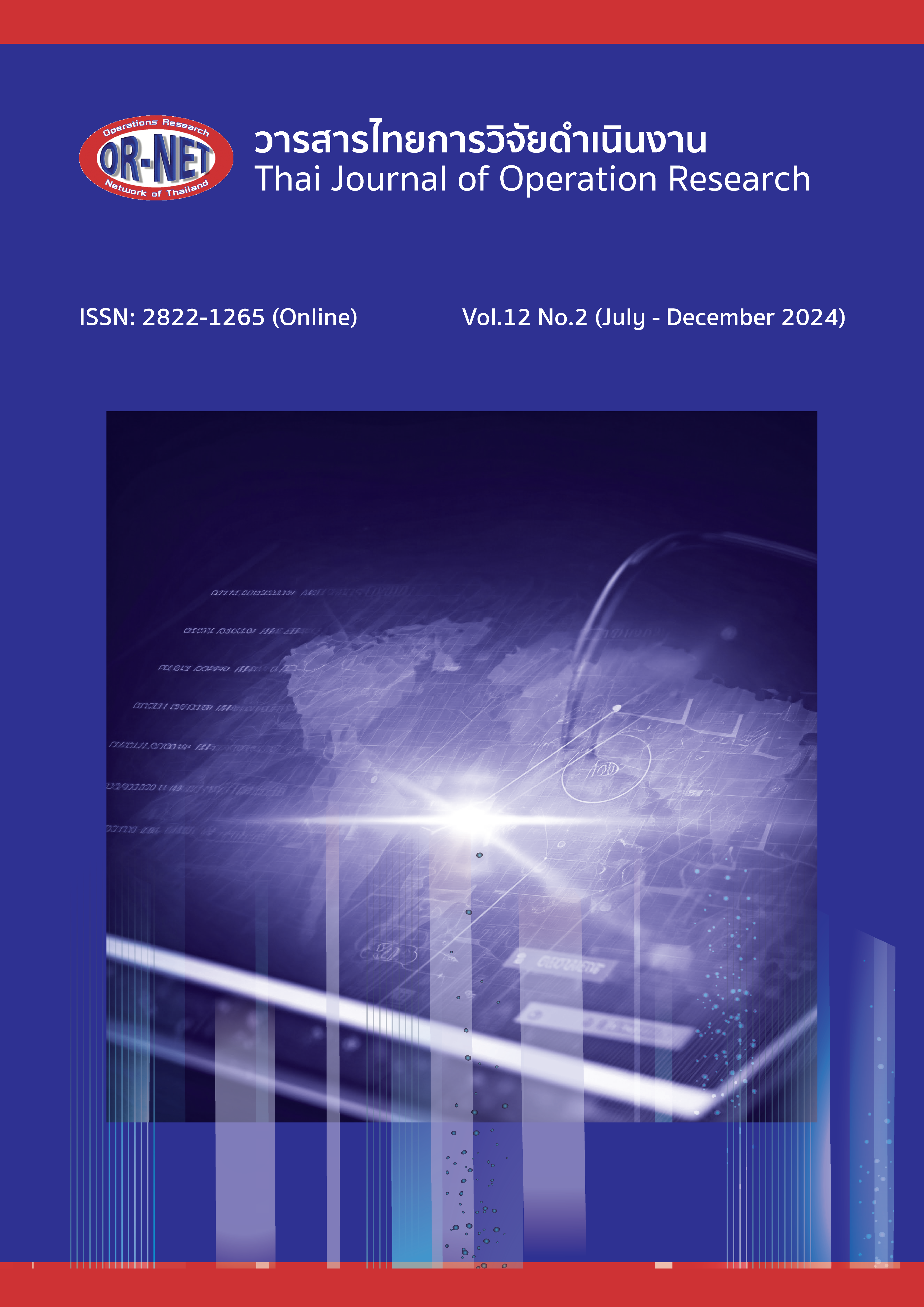An Integer Programming Model for Economic Crop Cultivation Planning with Single and Multiple Harvests in the Dry Season
Keywords:
integer programming model, economic crops, dry season, agricultural planning, return on investmentAbstract
Water scarcity during dry seasons presents a significant challenge for farmers, forcing them to make crucial decisions regarding crop selection. Short-term economic crops, offering single or multiple harvests, are often favored due to their faster turnaround. However, each crop has unique cultivation and harvesting windows. Therefore, optimizing crop planning is essential to maximize farmer profit under constraints of water availability, budget, and time. This study proposes an integer programming model for optimized crop planning. The model considers cultivation area, budgetary limitations, restricted water access, and harvesting periods to achieve maximum profit for farmers. Real data from the Baan Lung Khian Soei Som, Phetchaburi, Thailand Sufficient Economy Learning Center was used to test the model. Python, along with the Gurobi Optimization Package, facilitated the analysis. Budget variations between 75,000 and 275,000 Baht, and water volumes ranging from 3,500 to 5,000 cubic meters, were considered during model testing. The results identified an optimal budget of 250,000 Baht for crop cultivation, leading to maximum profit. Additionally, an analysis of return on investment revealed that a budget of 100,000 Baht paired with a water volume of 5,000 cubic meters yielded the highest return, translating to a 132.37% profit margin. The findings of this study highlight the crucial role of effective planning and budget allocation in crop cultivation. Strategic planning under water, land, budget, and harvesting time constraints can significantly enhance farmers' profits.
References
สำนักงานนโยบายและยุทธศาสตร์การค้า, “รมช.พณ. เผยสถิติการส่งออกสินค้าเกษตรไทย พร้อมแนะทุกภาคส่วนช่วยกันดูแลภาคเกษตร,” [ออนไลน์]. แหล่งที่มา: https://tpso.go.th/news/2402-0000000014. [วันที่เข้าถึง 22 กุมภาพันธ์ 2567].
กรมอุตุนิยมวิทยา, “ปริมาณฝนเฉลี่ยรายเดือนของประเทศไทย (มม.) ในคาบ 30 ปี,” [ออนไลน์]. แหล่งที่มา: https://tmd.go.th/ClimateChart/
monthly-mean-rainfall-in-thailand-mm-30-years?fbclid=IwAR3ufucR5s_l5BuLeZeW0LOpMEMfQkt0-Vtle3o7R3eo6N9K5KFKdcRDbEk. [วันที่เข้าถึง 22 ธันวาคม 2566].
J. Veintimilla-Reyes, D. Cattrysse, A. D. Meyer and J. V. Orshoven, “Mixed integer linear programming (MILP) approach to deal with spatio-temporal water allocation,” Procedia engineering., vol. 162, pp. 221-229, 2016.
พหล ศักดิ์คะทัศน์, พุฒิสรรค์ เครือคำ, และกังสดาล กนกหงษ์, “การจัดการน้ำสำหรับการเกษตรในภาวะภัยแล้งของเกษตรกรผู้ใช้น้ำ โครงการส่งน้ำและบํารุงรักษาแม่แฝก-แม่งัด อำเภอสันทราย จังหวัดเชียงใหม่,” วารสารวิจัยและส่งเสริมวิชาการเกษตร., ปีที่ 39, ฉบับที่ 3, น. 169-179, 2565.
D. K. Singh, C. S. Jaiswal, K. S. Reddy, R. M. Singh, and D. M. Bhandarkar, “Optimal cropping pattern in a canal command area,” Agricultural Water Management., vol. 50, no. 1, pp. 1-8, 2001.
พฤทธ์สรรค์ สุทธิไชยเมธี, “การประยุกต์ใช้ Linear Programming สำหรับการวางแผนการผลิตทางการเกษตรและติดตามผลการดำเนินงานตามหลักปรัชญาเศรษฐกิจพอเพียง,” วารสารสุทธิปริทัศน์., ปีที่ 26, ฉบับที่ 78, น. 19-36, 2555.
M. Sakellariou-Makrantonaki, C. Tzimopoulos, and V. Giouvanis, “Linear programming application for irrigation network management–implementation in the irrigation network region of Pinios (Central Greece),” Irrigation and Drainage., vol. 65, no. 4, pp. 514-521, 2016.
N. Hj. Mohamad and F. Said, “A mathematical programming approach to crop mix problem,” Advances in Food Science and Technology., vol. 7, no. 4, pp. 1-7, 2019.
Downloads
Published
How to Cite
Issue
Section
License

This work is licensed under a Creative Commons Attribution-NonCommercial-NoDerivatives 4.0 International License.




